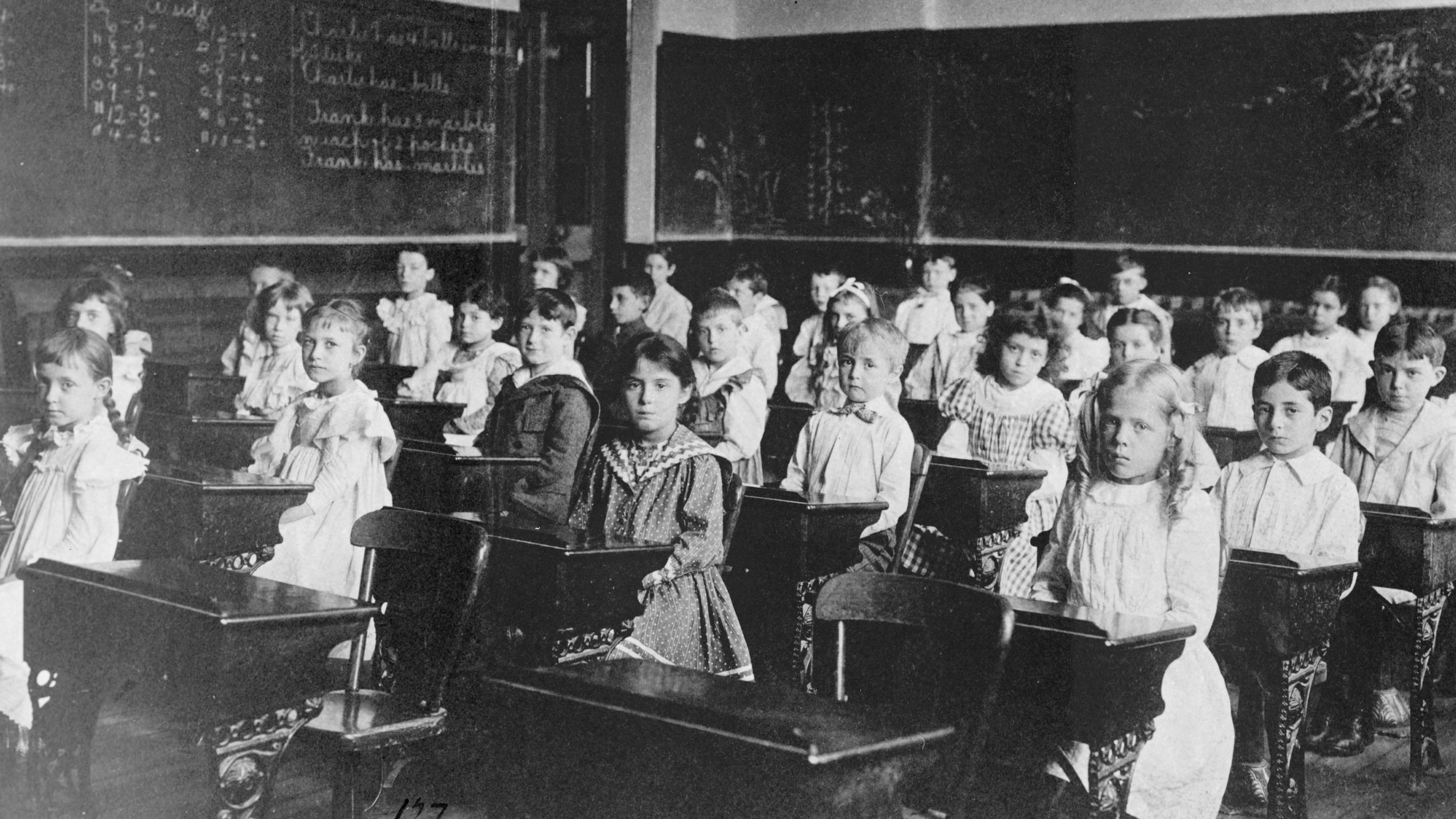Admiral Rockwell Tory
Diamond Member
There are "government" schools around the globe that do a fine job of educating their kids. Germany and Japan come to mind, but there are lots more countries that do a lot better job of it than we do here in the U.S. There is no reason why Government schools here could not be as effective.
Our kids in the U.S. are acculturated to be lazy and immature. They feel entitled to be entertained at school, and to receive instant gratification, both at home and in schools. They EXPECT an 'A' for any work product that is not manifestly defective. Even HR "professionals" tell managers that for anyone born after 1980, they must be constantly stroked and coddled or they will leave. At least once every 6 months they must get a promotion or a bonus or some other recognition of their wonderfulness, or they will become lethargic, unproductive, and gone.
Why are so many of our STEM professionals and professors foreigners? It's not genetics. It's the fact that you must work hard to master these subjects and American kids are generally not willing to work hard. Adolescence has been extended to age 40, and beyond. You will never hear a Math or Physics professor making the absurd statement that "there are no wrong answers on this test," as history and sociology teachers often do. You have to know your shit or you fail.
Socialism is the political preference of people who are both lazy in life and lazy thinkers, to boot. No one with any intelligence or ambition wants to be part of a labor union. (Craft unions are a tremendous benefit to our society; God bless them). Those who have never actually worked for a living or paid a significant amount of taxes LOVE socialism. Take from "the Rich," and give to "the Poor." What could be simpler than that? One of the follies of our educational system is that so many of the teachers have never had a real, responsible job in the private sector. They have the level of maturity of a college sophomore. How can we expect them to instill the values that made America great?
You can go through 17 years of American public education and NEVER EVEN HEAR that the most promising avenue to financial wealth in this country is entrepreneurship. They preach the gospel of getting a college degree, then a job with government or a big company, as the Land of Milk and Honey, which is basically nonsense.
I never said it was genetics.....but it certainly is Marxism/socialism at the heart of the problem.
An excellent choice of terms, "acculturation"....the assimilation of a different culture.
This one:
1. "Third-Grade Teacher Has Students Write ‘Get Well’ Cards To Cop Killer Mumia Abu-Jamal A third-grade teacher at a public school in New Jersey is under fire after she encouraged her students to write letters to notorious convicted cop killer Mumia Abu-Jamal, who recently fell ill in prison.
Marylin Zuniga teaches language arts and social studies at Forest Street School in Orange, N.J."
Third-Grade Teacher Has Students Write ‘Get Well’ Cards To Cop Killer Mumia Abu-Jamal
2. - School's Nation of Islam Handout Paints Founding Fathers as Racists
"School's Nation of Islam Handout Paints Founding Fathers as Racists
The teacher also told Sommer that her son was not supposed to take the Nation of Islam handout home. It was supposed to stay in the classroom. That bit of news caused her great alarm.
“The fact that students were cautioned against allowing their parents to see anything is deeply troubling,” West told me. “The only reasonable explanation is they don’t want parents to know what it is their children are learning.”
3. Under pressure from transgender activists, progressive politicians, teacher unions, and the education establishment, and despite parents’ opposition, America’s public schools are capitulating to ideologues and implementing the radical transgender agenda with full force.
...regardless of biological sex, .... Activists want every child, from kindergarten on, to learn that “sex” is something “assigned at birth” rather than a biological reality. They want children to think that individuals get to choose their own “gender identity” (not limited to male or female), and that everyone else must affirm that “gender identity” as true.
...nothing that parents (or teachers) can do to prevent the schools from imposing policies designed to indoctrinate children with gender ideology.
In public education, the “deep state” describes a coalition of various groups – including teachers’ unions, progressive advocacy groups, major corporations, and philanthropists --that work together to promote the progressive worldview..."
America’s Public Education System: The Ultimate Deep State
4. The National Education Association approved a new "business item" expressing support for abortion access during its annual conference in Houston.
"[T]he NEA will include an assertion of our defense of a person's right to control their own body, especially for women, youth, and sexually marginalized people," the resolution states. "The NEA vigorously opposes all attacks on the right to choose and stands on the fundamental right to abortion under Roe v. Wade."
The NEA is the largest teachers' union in the U.S. with more than 3 million members. It collected nearly $400 million from American educators in 2018, according to federal labor filings. The union is also one of the most politically active in the country, spending $70 million on politics and lobbying in 2017 and 2018. Nearly all of the union's political action committee spending went to Democrats during the midterm cycle, according to the Center for Responsive Politics.
NEA's 2019 adopted New Business Items (NBIs) reveal what savvy teachers have known for decades: state and national teachers' unions are essentially the political action committee of the Far-Left,"
Largest U.S. Teachers' Union Endorses Abortion
5. the 20-minute video being shown in American classrooms entitled The
Story of Stuff; a catchy title to appeal to grade school kids. This piece of anti-capitalist propaganda was
put together by Greenpeace member Annie Leonard.
6. NYC schools allow kids to go on #ClimateStrike
“TEN YEARS. We have ten years to save the planet,” Mayor Bill de Blasio cautioned in a tweet. “Today’s leaders are making decisions for our environment that our kids will have to live with. New York City stands with our young people. They’re our conscience. We support the 9/20 #ClimateStrike.”
Legions of adolescent activists across the globe are expected to demand immediate action to combat climate change in advance of a major UN conference on the issue next week.
As long as mom and dad sanction their principled truancy, absent kids won’t have attendance records dinged, the DOE said.
The September 20th event will feature Sweden’s “Climate Crisis” sweetheart, 16-year old Greta Thunberg.
Teen activist and Swedish sensation Greta Thunberg, who recently docked her zero-emissions sailboat in New York, will speak at the event which will snake its way through lower Manhattan to Battery Park.
Kids with parental permission to attend will be granted excused absences from school, Education Department officials tweeted Thursday.
The infamous “Green New Deal” will be promoted as well.
The New York City climate strike is backed by more than 100 environmental and political activist groups and other institutions, including New York Communities for Change, The New School and the Sierra Club.
The protesters’ demands include a “Green New Deal” that would end fossil fuel extraction and move the nation onto entirely renewable energy sources by 2030. Green New Deal policies have been backed by the likes of U.S. Rep. Alexandria Ocasio-Cortez and Vermont Sen. Bernie Sanders.
Personally, if I were one of the kids, I might argue about going to school at all. After all, if the Earth only has 10 more years before we are going to die, wouldn’t it be better to spend the time having fun or spending quality time with family?
On the other hand, if the New York City school officials were really invested in solving the climate crisis, wouldn’t they emphasize science and math? Perhaps keeping the kids in school and having them conduct experiments or perform calculations would inspire an interest in real climate science.
One theory that seems to prove true and is certainly consistent with what is happening with the New York City schools: When global problems are emphasized by locals, serious local matters are being ignored.
Case in point: New York state test results for third- through eighth-grade public school students are out, and the results are underwhelming.
Statewide, more than half the kids flunked yet again: Just 45.4% were deemed proficient in reading and 46.7% in math. In the city, 47.4% passed the reading test, while 45.6% got by in math.
Think the problem’s skimpy funding? Sorry: In 2017, the Empire Center’s E.J. McMahon reported in May, New York shelled out 89% more per kid than the national average. And that gap has been growing fast: In 1997, per-pupil outlays here were just 45% above average.
…In the city Thursday, Mayor Bill de Blasio and Schools Chancellor Richard Carranza tried to spin the results positively. The pass rate in English, they noted, is up 0.7 percentage points — and three whole points in math.
“Growth counts for something,” Carranza insisted.
Huh? That paltry uptick is what they’re proud of? Even though more than half the kids bombed? Please.
Notably, kids in the one category of public schools de Blasio and Carranza (and their union pals) don’t run — i.e., the charters — beat their counterparts in the regular schools by more than 10 percentage points in both English and math.
At least the kids won’t be flying private jets to attend the event. That makes them substantially less hypocritical than the celebrities who will be indoctrinating them during the Manhattan event.
NYC schools allow kids to go on #ClimateStrike
7. “Fifth-grade teacher defends wearing 'Columbus was a murderer' shirt to school” This story is no longer available - Washington Times earing-columbus-was-a/
8. “Seattle Public Schools Say Math Is Racist
The Seattle Public Schools Ethnic Studies Advisory Committee (ESAC) released a rough draft of notes for its Math Ethnic Studies framework in late September, which attempts to connects math to a history of oppression.” Seattle Public Schools Say Math Is Racist
9. “The sex and gender revolutionaries have officially taken over the Austin Independent School District without firing a single shot. In spite of overwhelming opposition from parents and pastors, the district’s trustees voted early Tuesday morning to implement a pornographic sex education policy that includes instruction on anal sex and how to place a condom on an erect penis.
The father of a fifth grader demanded to know who gave the school district the right to teach his child how to have anal and oral sex.” Texas School District Implements Pornographic Sex Education Policy
10.” It appears the Chicago Teachers Union (CTU), which held a solidarity rally this Saturday afternoon, …. seemed more like a convention of far-left radicals than the image of clean-cut teachers the CTU would like to project. Thousands of red-shirted Chicago Teachers Union members flooded into Chicago’s aptly named Union Square Park at noon today to demonstrate for solidarity and workers’ rights. Protesters embraced radical revolutionary imagery, wearing shirts with Che Guevara on them and holding signs emblazoned with the “iron fist.”
Occupy Chicago and anarchist groups as well as the Progressive Labor Party, International Socialists, SEIU, AFL-CIO, and others stood alongside teachers chanting for solidarity…” Radical left coalesces around Chicago Teacher protest
More
In the vid, teacher’s union with the Socialist iron fist banner…
11. “Racial Literacy Curriculum,” elementary schools in Virginia, North Carolina, New Jersey, New York, California, Rhode Island, Missouri, and Illinois have all adopted the mind-blowing, politically-charged brainwash that they tout as education. Topics for Kindergarten to Grade 8 include: implicit bias, white privilege, intersectionality, LGBTQ issues, racism as a “primary institution of the US,” and other such leftist agenda talking points.” EXCLUSIVE: New Leftist ‘Racial Literacy Curriculum’ Brainwashing Elementary School Children
12. The Pollyana Curriculum…nationwide
“Beginning in Grade 3, the Pollyanna "Racial Literacy Curriculum" asks students to become activists in order to achieve leftist goals. The 3rd Grade chapter is entitled "Stories of Activism – How One Voice Can Change a Community." The expected result is for students to understand "how we can be agents of communal, social, political, and environmental change."
…Pollyanna takes leftist activism to new heights, fabricating an image of a racist America that children are taught to rebel against.
By Grade 8,after nine years of acute indoctrination, the children are ready to fight on behalf of leftists in America. "tudents will set commitments for rectifying current social ills, such as learning and planning how to carry out anti-racist activism and/or social advocacy in their communities and/or to improve their everyday lives." The 8th Grade chapter is entitled "Racism as a Primary 'Institution' of the U.S. – How We May Combat Systemic Inequality." EXCLUSIVE: Leftist Activism Is A Requirement Of New Elementary School Curriculum
13. “Minnesota ‘Teacher of the Year’ takes knee during National Anthem at NCAA title game” Minnesota ‘Teacher of the Year’ takes knee during National Anthem at NCAA title game | The College Fix
14. "School in Brooklyn Hands Out “Drag Queen in Training” Stickers to 4-Year-Olds” School in Brooklyn Hands Out “Drag Queen in Training” Stickers to 4-Year-Olds
15. “Teacher: “No Regrets” for Desecrating American Flag in Classroom” Teacher: “No Regrets” for Desecrating American Flag in Classroom
Do you have any example from red states? Didn't think so.





